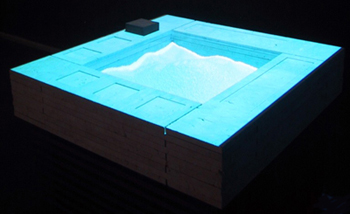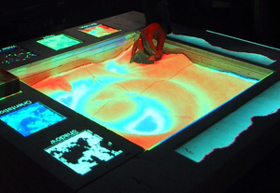
|
Keynotes
 |
Bernhard Graimann
Research Scientist in the Institute of Human Computer Interfaces at the University of Technology Graz
http://www-dpmi.tu-graz.ac.at/
|
| |
| | About |
| | |
Bernhard Graimann is an Assistant Research Scientist in the Institute of Human Computer Interfaces at the University of Technology Graz. He received the M.S. degree in computer science and the Ph.D. degree in biomedical engineering from the University of Technology Graz, Austria, in 1999 and 2002, respectively.
Bernhard Graimann's research focuses on the analysis of brain patterns in bioelectrical recordings associated with motor imagery and especially on the design of brain-computer interfaces. In an NIH funded research collaboration with the Department of Biomedical Engineering and the Department of Physical Medicine and Rehabilitation at the University of Michigan, he is currently investigating the potential of subdural (ECoG) recordings as the basis of direct brain-computer communication. He has contributed to the statistical analysis of oscillatory activity in brain signals, and developed optimization methods and advanced signal processing algorithms for increasing the performance of brain-computer interfaces.
|
| | Talk Abstract |
| | |
Human-computer interfaces (HCI) are an important field of research in pervasive computing. Innovative interfaces based on voice or vision have been devised to improve the usability of human-computer interaction. A new dimension to HCI is added by brain computer interfaces (BCI). Such a BCI establishes a communication channel directly between the brain and a computer. The ultimate goal is to provide effective communication without using the normal neuromuscular output pathways of the brain, but by accepting commands directly encoded in neurophysiological signals. For people who are locked-in after having lost all voluntary muscle control due to severe neurological diseases, a BCI may be their only means of communication with their environment. Existing BCI systems have demonstrated that direct communication between the brain and a computer is indeed possible, but a significant amount of research is still needed to solve many complex problems such as the limited information transfer rate of current BCIs, which is at best 25 bits/min. For people who are locked-in after having lost all voluntary muscle control due to severe neurological diseases, a BCI may be their only means of communication with their environment. Existing BCI systems have demonstrated that direct communication between the brain and a computer is indeed possible, but a significant amount of research is still needed to solve many complex problems such as the limited information transfer rate of current BCIs, which is at best 25 bits/min. Although this bit rate is sufficient to provide basic communication for people with severe motor impairments, a further increase in speed will be required before general users of pervasive computing devices will adopt such interfaces. Although this bit rate is sufficient to provide basic communication for people with severe motor impairments, a further increase in speed will be required before general users of pervasive computing devices will adopt such interfaces.
This presentation will include a brief history of brain-computer communication, an overview of the state-of-the-art in BCI research, and will give future perspectives for this fascinating and multidisciplinary research field. A short movie will demonstrate how the motor function of a paralyzed patient can be restored by means of a BCI.
|
| | About |
| | |
Hiroshi Ishii is a tenured Associate Professor of Media Arts and Sciences, at the MIT Media Lab. He co-directs Things That Think (TTT) consortium and directs Tangible Media Group. Hiroshi Ishii's research focuses upon the design of seamless interfaces between humans, digital information, and the physical environment.
At the MIT Media Lab, he founded and directs the Tangible Media Group pursuing a new vision of Human Computer Interaction (HCI): "Tangible Bits." His team seeks to change the "painted bits" of GUIs to "tangible bits" by giving physical form to digital information.
Ishii and his students have presented their vision of "Tangible Bits" at a variety of academic, industrial design, and artistic venues (including ACM SIGCHI, ACM SIGGRAPH, Industrial Design Society of America, Ars Electronica, and Centre Pompidou), emphasizing that the development of tangible interfaces requires the rigor of both scientific and artistic review. A display of many of the group's projects took place at the NTT InterCommunication Center (ICC) in Tokyo in summer 2000. A new, three-year-long exhibition "Get in Touch" that features the Tangible Media group's work opened at Ars Electronica Center (Linz, Austria) in September 2001.
Prior to MIT, from 1988-1994, he led a CSCW research group at the NTT Human Interface Laboratories, where his team invented TeamWorkStation and ClearBoard. In 1993 and 1994, he was a visiting assistant professor at the University of Toronto, Canada. He received B. E. degree in electronic engineering, M. E. and Ph. D. degrees in computer engineering from Hokkaido University, Japan, in 1978, 1980 and 1992, respectively.
|
| | Talk Abstract |
| | |
Where the sea meets the land, life has blossomed into a myriad of unique forms in the turbulence of water, sand, and wind. At another seashore between the land of atoms and the sea of bits, we are now facing the challenge of reconciling our dual citizenships in the physical and digital worlds. 
Windows to the digital world are confined to flat square ubiquitous screens filled with pixels, or "painted bits." Unfortunately, one can not feel and confirm the virtual existence of this digital information through one's body.
 Tangible Bits, our vision of Human Computer Interaction (HCI), seeks to realize seamless interfaces between humans, digital information, and the physical environment by giving physical form to digital information, making bits directly manipulable and perceptible. The goal is to blur the boundary between our bodies and cyberspace and to turn the objects and architectural space into an interface.
Tangible Bits, our vision of Human Computer Interaction (HCI), seeks to realize seamless interfaces between humans, digital information, and the physical environment by giving physical form to digital information, making bits directly manipulable and perceptible. The goal is to blur the boundary between our bodies and cyberspace and to turn the objects and architectural space into an interface.
 In this talk, I will present a variety of tangible user interfaces the Tangible Media Group has designed and presented within the CHI, SIGGRAPH, UIST, CSCW, IDSA, ICSID, ICC, and Ars Electronica communities in the past several years.
http://tangible.media.mit.edu
In this talk, I will present a variety of tangible user interfaces the Tangible Media Group has designed and presented within the CHI, SIGGRAPH, UIST, CSCW, IDSA, ICSID, ICC, and Ars Electronica communities in the past several years.
http://tangible.media.mit.edu
|
|

